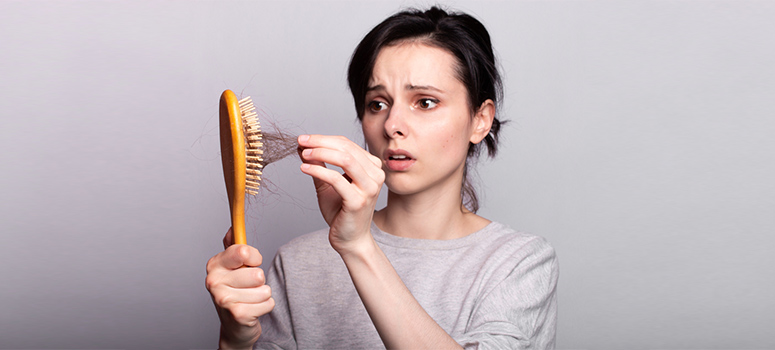Monsoon has a soothing effect on your mind but not on your health. It brings with it a lot of problems, and hair loss is one of them. During the monsoon season, the humidity messes with your hair making them frizzy and unmanageable, resulting in hair loss.
Hair loss is a common problem in both men and women. It tends to be a little out of hand during the monsoon season because the moisture content in the air makes your scalp wet and oily. This weakens the roots resulting in losing more hair strands than usual.
Though hair fall in the rainy season is completely natural and temporary. You don’t need to worry about it unless you lose more than 50-100 strands of hair daily. In this article, we’ll take you through the types of hair fall to help you understand if it is a normal hair shedding episode or if it is time to see a dermatologist.
Getting to the Roots of Hair Loss
Before getting into the nitty-gritty of types of hair loss, let’s first understand its symptoms and causes. We tend to overlook hair loss unless it shows in ways like finding hair all over the place, reduced hair volume, and scalp visible through the hair.
Here is a list of symptoms that provide some clues:
- Widening hair partition
- Receding hairline
- More hair than usual on your comb
- Clogged sink and shower drains
- Bald patches
- Pain or itching on your scalp
Hair loss can be caused due to the following reasons:
- Poor nutrition
- Hormonal imbalance
- Stress
- Cancer treatment
- Childbirth
Symptoms and causes of hair fall differ from person to person. Identifying the cause of hair fall in your case is important to get the right treatment to stop hair loss.
Types of Hair Loss
Hair loss type can be determined by what causes it. Here we have listed common hair loss types in both men and women. Though they may not be specific to hair fall in the rainy season, this is a piece of vital information to help you understand the type of hair loss you are experiencing.
- Androgenic alopeciaAndrogenic alopecia is caused due to hereditary reasons. If someone in your family has suffered from hair loss, it’ll likely cause your hair loss too. This type of hair loss happens gradually. Some people experience hair loss when they hit puberty, while others notice the symptoms sooner than they reach the teenage phase.Male or female pattern baldness comes under androgenic alopecia and is very common. In the case of female pattern baldness, people may notice hair thinning or widening parts. On the other hand, male pattern baldness usually involves hair loss above the temples or hair thinning at the crown of the head.
- Alopecia AreataThis hair loss is an autoimmune condition that causes the immune system to attack the hair follicles. This condition results in bald patches and also hair loss in some cases. People who suffer from Alopecia Areata lose hair on the scalp, eyebrows, eyelashes and other body parts.
- Anagen EffluviumPeople who undergo chemotherapy or radiation treatment as a part of the cancer treatment suffer from Anagen Effluvium. In this, a person rapidly losses hair, but the hair growth restores after the treatment is over.
- Telogen EffluviumTelogen Effluvium is a type of hair loss that is caused due to emotional shock, trauma, extreme stress, or a severe illness. In some cases, Telogen Effluvium is caused due to hormonal changes due to pregnancy, childbirth or menopause. This type of hair fall is not permanent. It gets resolved once the issue that was causing it is addressed.
- Tinea CapitisThis type of hair loss is caused due a fungal infection called ringworm. This condition affects the scalp and causes circular bald patches which look like a ring, are itchy and have scaly edges. If not treated, the size of the patches increases resulting in more hair loss.People who suffer from Tinea Capitis experience scalp tenderness, grey and red scaly patches of skin, and hair breakage. This type of hair loss is completely treatable with the help of antifungal medication.
- Traction alopecia
Traction alopecia is a type of hair loss that is caused due to repeatedly pulling your hair. Tight hairstyles like braids, ponytails, or buns result in hair loss. You can stop hair loss of this kind by giving your hair some rest and not subjecting it to any pressure or tension. It is important to act on this type of hair loss as the hair follicles can become damaged and scarred that they can’t produce new hair.
Common treatments for hair loss
Though a wide range of treatment options are available to stop hair loss, the best one will depend on the cause of hair loss in your case. Most of the treatments begin with medications. Depending upon the progress, the dermatologist will suggest the following treatment course.
Dermatologists also recommend some OTCs that consist of topical creams, gels, solutions, or foam. If the cause of hair loss is severe and medications do not work, your dermatologist might suggest a hair transplant surgery or scalp reduction as a treatment for hair loss.
Take the right approach toward hair loss.
If you are experiencing hair fall in the rainy season, it is always best to consult a dermatologist than waste time and money on OTC hair products. Without knowing the cause of your hair loss, using OTC products is like a shot in the dark.
A dermatologist will help you identify the root cause and treat your hair loss by suggesting a treatment that works best in your case. At Skin and Hair Academy, you can connect to expert dermatologists across the country as well as get insightful content on various hair issues curated by them.














